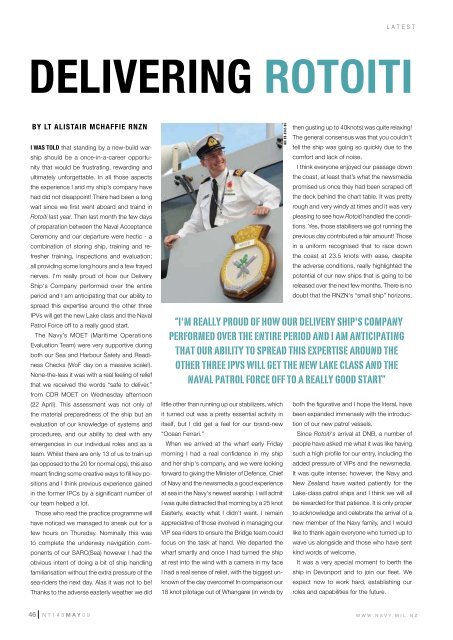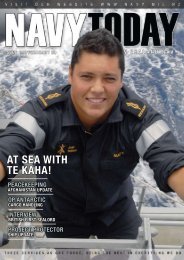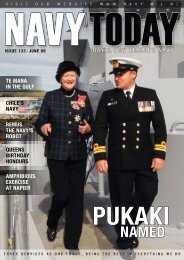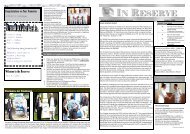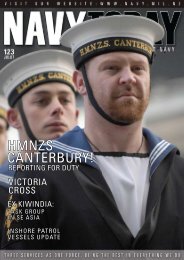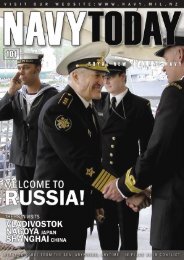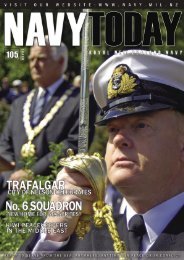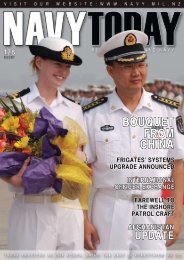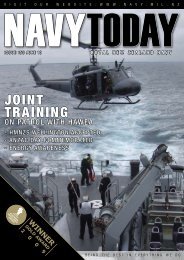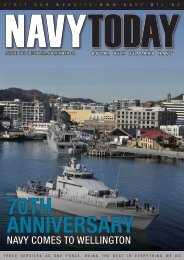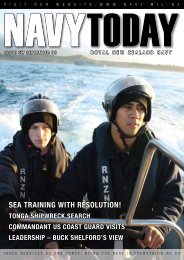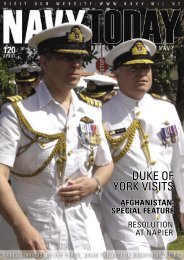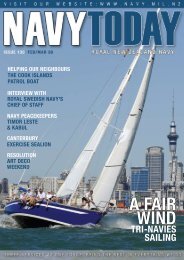Navy Today May 09 | Issue 143 - Royal New Zealand Navy
Navy Today May 09 | Issue 143 - Royal New Zealand Navy
Navy Today May 09 | Issue 143 - Royal New Zealand Navy
Create successful ePaper yourself
Turn your PDF publications into a flip-book with our unique Google optimized e-Paper software.
LATEST<br />
DELIVERING ROTOITI<br />
By LT Alistair McHaffie RNZN<br />
I was told that standing by a new-build warship<br />
should be a once-in-a-career opportunity<br />
that would be frustrating, rewarding and<br />
ultimately unforgettable. In all those aspects<br />
the experience I and my ship’s company have<br />
had did not disappoint! There had been a long<br />
wait since we first went aboard and traind in<br />
Rotoiti last year. Then last month the few days<br />
of preparation between the Naval Acceptance<br />
Ceremony and our departure were hectic - a<br />
combination of storing ship, training and refresher<br />
training, inspections and evaluation;<br />
all providing some long hours and a few frayed<br />
nerves. I'm really proud of how our Delivery<br />
Ship's Company performed over the entire<br />
period and I am anticipating that our ability to<br />
spread this expertise around the other three<br />
IPVs will get the new Lake class and the Naval<br />
Patrol Force off to a really good start.<br />
The <strong>Navy</strong>’s MOET (Maritime Operations<br />
Evaluation Team) were very supportive during<br />
both our Sea and Harbour Safety and Readiness<br />
Checks (WoF day on a massive scale!).<br />
None-the-less it was with a real feeling of relief<br />
that we received the words “safe to deliver,”<br />
from CDR MOET on Wednesday afternoon<br />
(22 April). This assessment was not only of<br />
the material preparedness of the ship but an<br />
evaluation of our knowledge of systems and<br />
procedures, and our ability to deal with any<br />
emergencies in our individual roles and as a<br />
team. Whilst there are only 13 of us to train up<br />
(as opposed to the 20 for normal ops), this also<br />
meant finding some creative ways to fill key positions<br />
and I think previous experience gained<br />
in the former IPCs by a significant number of<br />
our team helped a lot.<br />
Those who read the practice programme will<br />
have noticed we managed to sneak out for a<br />
few hours on Thursday. Nominally this was<br />
to complete the underway navigation components<br />
of our SARC(Sea) however I had the<br />
obvious intent of doing a bit of ship handling<br />
familiarisation without the extra pressure of the<br />
sea-riders the next day. Alas it was not to be!<br />
Thanks to the adverse easterly weather we did<br />
little other than running up our stabilizers, which<br />
it turned out was a pretty essential activity in<br />
itself, but I did get a feel for our brand-new<br />
“Ocean Ferrari.”<br />
When we arrived at the wharf early Friday<br />
morning I had a real confidence in my ship<br />
and her ship's company, and we were looking<br />
forward to giving the Minister of Defence, Chief<br />
of <strong>Navy</strong> and the newsmedia a good experience<br />
at sea in the <strong>Navy</strong>'s newest warship. I will admit<br />
I was quite distracted that morning by a 25 knot<br />
Easterly, exactly what I didn’t want. I remain<br />
appreciative of those involved in managing our<br />
VIP sea riders to ensure the Bridge team could<br />
focus on the task at hand. We departed the<br />
wharf smartly and once I had turned the ship<br />
at rest into the wind with a camera in my face<br />
I had a real sense of relief, with the biggest unknown<br />
of the day overcome! In comparison our<br />
18 knot pilotage out of Whangarei (in winds by<br />
MC <strong>09</strong>-0141-06<br />
then gusting up to 40knots) was quite relaxing!<br />
The general consensus was that you couldn't<br />
tell the ship was going so quickly due to the<br />
comfort and lack of noise.<br />
I think everyone enjoyed our passage down<br />
the coast, at least that’s what the newsmedia<br />
promised us once they had been scraped off<br />
the deck behind the chart table. It was pretty<br />
rough and very windy at times and it was very<br />
pleasing to see how Rotoiti handled the conditions.<br />
Yes, those stabilisers we got running the<br />
previous day contributed a fair amount! Those<br />
in a uniform recognised that to race down<br />
the coast at 23.5 knots with ease, despite<br />
the adverse conditions, really highlighted the<br />
potential of our new ships that is going to be<br />
released over the next few months. There is no<br />
doubt that the RNZN's “small ship” horizons,<br />
“I'm really proud of how our Delivery Ship's Company<br />
performed over the entire period and I am anticipating<br />
that our ability to spread this expertise around the<br />
other three IPVs will get the new Lake class and the<br />
Naval Patrol Force off to a really good start”<br />
both the figurative and I hope the literal, have<br />
been expanded immensely with the introduction<br />
of our new patrol vessels.<br />
Since Rotoiti's arrival at DNB, a number of<br />
people have asked me what it was like having<br />
such a high profile for our entry, including the<br />
added pressure of VIPs and the newsmedia.<br />
It was quite intense; however, the <strong>Navy</strong> and<br />
<strong>New</strong> <strong>Zealand</strong> have waited patiently for the<br />
Lake-class patrol ships and I think we will all<br />
be rewarded for that patience. It is only proper<br />
to acknowledge and celebrate the arrival of a<br />
new member of the <strong>Navy</strong> family, and I would<br />
like to thank again everyone who turned up to<br />
wave us alongside and those who have sent<br />
kind words of welcome.<br />
It was a very special moment to berth the<br />
ship in Devonport and to join our fleet. We<br />
expect now to work hard, establishing our<br />
roles and capabilities for the future.<br />
HMNZS ROTOITI sails up the<br />
Rangitoto Channel on 24<br />
April, past the volcano<br />
that guards the entrance<br />
to Auckland. The NZ White<br />
Ensign is flying from the<br />
main mast, along with<br />
the ship’s international<br />
call sign ZMZM. Two HF<br />
whip aerials rise from the<br />
forward superstructure,<br />
satellite domes are high on<br />
the bridge and main mast.<br />
Photo: LAC Grant Armishaw NPU.<br />
MC <strong>09</strong>-0140-002<br />
46 NT<strong>143</strong>MAY<strong>09</strong> WWW.NAVY.MIL.NZ<br />
WWW.NAVY.MIL.NZ NT<strong>143</strong>MAY<strong>09</strong> 47


